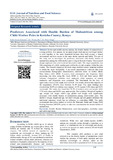Predictors Associated with Double Burden of Malnutrition among Child-Mother Pairs in Kericho County, Kenya

View/
Date
2022-12Author
Kimutai, Faith Jerono
Bor, Wesley
Chege, Peter
Metadata
Show full item recordAbstract
In low-and middle-income nations, the double burden of malnutrition is
a rising problem. It is unusual for an underweight child and an overweight mother
to exist together in the same household because they both occupy a shared
environment and have access to the same dietary patterns and habits. The aim of
this study was to investigate the predictors associated with double burden of
malnutrition among the child-mother pairs living in Kericho County. The research
design employed was cross-sectional descriptive study. The target population was
346 comprising of a child- mother pairs within the six sub-counties within Kericho
County. The research employed the multi-stage stratified cluster sampling method
to obtain the target households. A pre-tested questionnaire collected data from
socioeconomic demographic characteristics, nutrition status for mother (Body
Mass Index,) child (BMI- Z-scores), food consumption and frequency. Data
processing was done using Ms Excel, SPSS vs. 26.0 and Nutri survey 2005
software. Categorical variables were analyzed, while measures of central
tendencies and dispersion were computed. The benchmark for the level of
significance were at 0.05 alpha level (p<0.05. The results showed that majority of
the respondents (57.6%) were between 36-49 years. The study findings also
revealed that 18.9% of children were stunted, 11.5% wasted, 5.8% obese and 8.1%
overweight. The study also found that 28.1% of mothers were overweight while
7.7% were obese and 16.9% were underweight. The variables: Weight of; mother’s
age, weight and height, child’s age, gender and weight were significantly
associated with double burden of malnutrition among child-mother pairs. The
mother’s weight, height and age, the child’s weight, age and gender influences the
nutritional outcomes which has an influence in controlling DBM. The study
recommends that policy makers to review the Maternal, Infant and Young Child
Feeding Nutrition (MIYCN) policy to take into consideration the double burden of
malnutrition.
